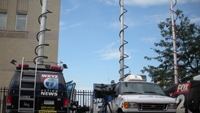Detroit stations transition to new 2GHz BAS channels

The sight of having ENG vehicles from every news station in the Detroit market lined up in a single parking lot is a “once-in-a-lifetime experience” — at least Jeffrey Liebman, manager of news operations for WDIV-TV, hopes it is.
The gathering of microwave trucks from Fox O&O WJBK-TV, Scripps-owned ABC affiliate WXYZ-TV, CBS O&O WWJ and Post Newsweek Stations-owned NBC affiliate WDIV-TV on the rainy Saturday morning of July 11 in WDIV’s downtown parking lot was the penultimate event in the market’s conversion to the new digital 2GHz Broadcast Auxiliary Service band plan.
The finale, a conference call later that day among the stations’ chief engineers, truck operators in the parking lot and the stations’ receive teams, played out as each vehicle in turn powered up in digital mode transmitting to a central receive site in downtown Detroit — a test run that enabled operators to make last-minute tweaks.
The success of the 2GHz BAS transition in the Detroit market comes down to three things: communication, coordination and training, Liebman says. At WDIV, which transitioned 11 microwave trucks, two SNG vehicles, two helicopters and fixed microwave assets at city hall and a sports arena, dialog about the transition started long before the station ever received its first Microwave Radio Communications MTX5000 radio.
“We made sure there was a lot of information posted in an easy-to-read manner, and we did a series of meetings with our photography teams and receive teams; we kept them informed. That started about six months ago,” Liebman says.
As awareness of the transition grew, WDIV implemented a training strategy that relied on broadcast systems solution firm AZCAR Technologies to provide training materials and conduct classes. “We made their training seminars mandatory, and I, along with our engineering team, sat through a series of them,” Liebman says. Everyone in the newsroom also was required to attend the training, and the training seminars were recorded to DVD, which looped over an in-house channel at WDIV for the two weeks leading up to the transition.
Coordinating the 2GHz BAS relocation required striking a delicate balance between meeting ongoing newsgathering requirements and taking vehicles out of service to be updated, Liebman says. “The people on the assignment desk don’t like to lose any equipment for editorial reasons,” he says, “and like most TV stations, we don’t have spare microwave trucks sitting off to the side.”
Get the TV Tech Newsletter
The professional video industry's #1 source for news, trends and product and tech information. Sign up below.
To convert its ENG trucks, the station released one vehicle at a time to truck integrator Frontline Communications for a conversion process that on average took three to four days, he says. “So as long as you keep the organization aware of what you are doing, through communications both verbally and with a lot of sign postings and a lot of pre-warning, you can get a fleet converted. And then it is still painful, but you try to minimize the pain.”
Editor’s note: Part II of this article will appear in the “ENG Update” newsletter that blasts to subscribers July 22. It also will be available on the Broadcast Engineering Web site.
Phil Kurz is a contributing editor to TV Tech. He has written about TV and video technology for more than 30 years and served as editor of three leading industry magazines. He earned a Bachelor of Journalism and a Master’s Degree in Journalism from the University of Missouri-Columbia School of Journalism.

